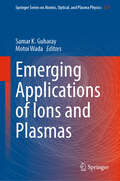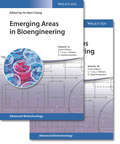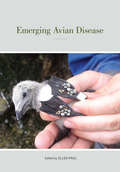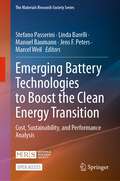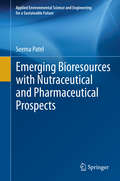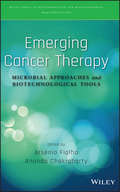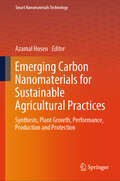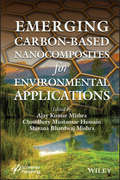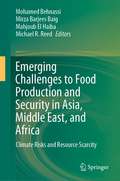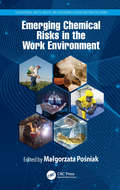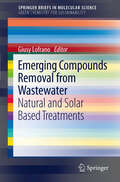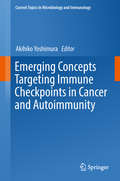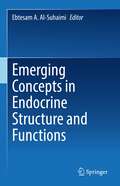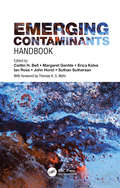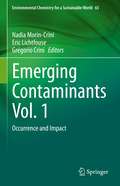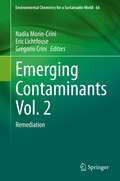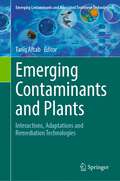- Table View
- List View
Emerging Applications of Control and Systems Theory: A Festschrift In Honor Of Mathukumalli Vidyasagar (Lecture Notes In Control And Information Sciences - Proceedings Ser.)
by Roberto Tempo Stephen Yurkovich Pradeep MisraThis book celebrates Professor Mathukumalli Vidyasagar’s outstanding achievements in systems, control, robotics, statistical learning, computational biology, and allied areas. The contributions in the book summarize the content of invited lectures given at the workshop “Emerging Applications of Control and Systems Theory” (EACST17) held at the University of Texas at Dallas in late September 2017 in honor of Professor Vidyasagar’s seventieth birthday. These contributions are the work of twenty-eight distinguished speakers from eight countries and are related to Professor Vidyasagar’s areas of research. This Festschrift volume will remain as a permanent scientific record of this event.
Emerging Applications of Ions and Plasmas (Springer Series on Atomic, Optical, and Plasma Physics #127)
by Samar K. Guharay Motoi WadaThis book discusses recent advances in the science and technology of charged particles and emerging frontiers in applications of ions and plasmas. In particular, this includes: ion/plasma interactions with soft matters, especially, interrogating local bio cells, bio systems, liquids and gels; interactions with ambient environments; processes associated with fine-scale characterization of materials, materials modification, new material discovery, and above all, plasma chemistry. The book takes a broad view of the underlying problems with a distinct aim to engage young researchers and even advanced undergraduate and beginning graduate students. The first few chapters discuss relevant broad science issues covering ions and plasmas as well as methodologies for their manipulations; in addition, mathematical and computational tools for analysis are highlighted through simple examples. This background knowledge, in turn, develops a solid foundation for the chapters on numerous emerging application areas. A balance between science and engineering, along with relevant computational modeling, simulation, and exploitation of data, is maintained throughout. Prospective outlooks for the future are discussed. Overall, this book offers a lens for the reader to get acquainted with active and fruitful emerging application domains for future explorations.
Emerging Applications of Novel Nanoparticles (Lecture Notes in Nanoscale Science and Technology #37)
by Pallav Gupta Suneev Anil Bansal Virat Khanna Nilanthy BalakrishnanThis book is a comprehensive and modern guide on emerging nanoparticles and their diverse applications in engineering, medicine, food safety, transportation, energy, agriculture, and environmental sustainability. Written by leading researchers from all over the world, it is designed to cover the full range of nanoparticles as well as provide in-depth detail regarding their development, characterization, processing, and synthesis. The book is divided into two sections: the first covers the development of advanced nanoparticles and the second is dedicated to their variety of cutting-edge applications. The authors also cover the unique properties and green synthesis of nanoparticles as well as their use as nanobiosensors, nanopesticide, nanofertilizer, and as energy storage and conversion devices, just to name a few. This book provides readers with insight onto the broad scope of computational, theoretical, and experimental research on novel nanoparticles and their applications. It is ideal for both young and experienced researchers and industry professionals in the field of nanotechnology.
Emerging Areas in Bioengineering
by Jens Nielsen Gregory Stephanopoulos Sang Yup Lee Ho Nam ChangWith more than 40 contributions from expert authors, this is an extensive overview of all important research topics in the field of bioengineering, including metabolic engineering, biotransformations and biomedical applications. Alongside several chapters dealing with biotransformations and biocatalysis, a whole section is devoted to biofuels and the utilization of biomass. Current perspectives on synthetic biology and metabolic engineering approaches are presented, involving such example organisms as Escherichia coli and Corynebacterium glutamicum, while a further section covers topics in biomedical engineering including drug delivery systems and biopharmaceuticals. The book concludes with chapters on computer-aided bioprocess engineering and systems biology. This is a part of the Advanced Biotechnology book series, covering all pertinent aspects of the field with each volume prepared by eminent scientists who are experts on the topic in question. Invaluable reading for biotechnologists and bioengineers, as well as those working in the chemical and pharmaceutical industries.
Emerging Avian Disease
by Ellen PaulIn this volume, new human disease pandemics, arising from animals stimulated by ongoing environmental change, demonstrate the value of ornithological research into avian diseases. A group of 29 researchers addresses a diverse set of topics, including the evolutionary and ecological aspects of the host-vector systems, the effects of genetic variation, introduction success and vector ecology, evolution of resistance and virulence of pathogens, and the effects of changing geographic distributions. In addition to empirical studies under field conditions, the authors present predictive models to assess the movement and potential impact of these diseases. Other chapters delve into the potential impacts of pathogens and the key role of biosurveillance and documenting impacts of disease on bird populations.
Emerging Battery Technologies to Boost the Clean Energy Transition: Cost, Sustainability, and Performance Analysis (The Materials Research Society Series)
by Linda Barelli Stefano Passerini Manuel Baumann Jens F. Peters Marcel WeilThis open access book provides a totally new perspective on the rapidly developing sector of electrochemical energy storage, putting a spotlight on their sustainability under consideration of the latest developments and emerging future technologies. A number of selected, high-level authors from different disciplines discuss the potential contribution of batteries to a cleaner society, the need for new battery concepts, necessary new chemistries and their sustainability. These include not only analyses of the most relevant technological developments in the field, but also the latest state of knowledge in terms of their applicative functionalities in transport and stationary applications within the clean energy transition framework, their potential environmental impacts, resource demands and social impacts, and the corresponding methodological advances. All these aspects are analyzed on micro-level (i.e., for the specific technology), but also on macro-scale i.e., from a systemic perspective, providing a glimpse on how emerging battery systems might cover future energy storage demand. By taking a prospective and interdisciplinary viewpoint, this book will be of interest for a broad field of readers interested in electrochemistry, engineering with particular focus on electric grids and on-board systems and energy system analysis, but also those worried about the sustainability and societal challenges related with the energy transition(s).
Emerging Bioresources with Nutraceutical and Pharmaceutical Prospects
by Seema PatelThis book introduces some emerging functional foods that are natural resources with tremendous promise as nutraceuticals and pharmaceuticals. The author considers biodiversity and bioprospecting as a response to food security issues, drug-resistance, nutrition-poor diets and other problems, exploring the prospects of several under-utilized nutrients and bioactive repositories. Readers will discover biochemical makeups, validated health benefits, explanations of underlying mechanisms, hurdles in the path of popularity and promotion strategies. Chapters explore particular plants, seeds and fruits including the strawberry guava, opuntia fruits, the Carissa genus, grape seeds, quinoa and the milk thistle (Silybum), amongst others. They are considered as food sources where possible and from the perspective of the roles they can play in complementary and alternative medicine, such as in wound healing, antimicrobial activity, gastroprotective activity in treatment of cancers and as natural antioxidant sources. This rich compilation holds plausible solutions to a range of current issues and it endorses the much-needed goal of sustainability in terms of diet and drugs. It paves the path for further research and development on hitherto obscure natural resources. Scientists working in the area of food development, phytochemical and antioxidant analysis, bioprospecting of low-profile foods and in complementary and alternative medicine will find this work particularly valuable. It will also be of interest to the general reader with an interest in food science, food security, phytochemicals and functional food studies.
Emerging Cancer Therapy: Microbial Approaches and Biotechnological Tools (Wiley Series in Biotechnology and Bioengineering #3)
by Ananda Chakrabarty Arsenio FialhoExplores current and emerging applications of microbes as cancer-fighting agents WILEY SERIES IN BIOTECHNOLOGY AND BIOENGINEERING Anurag S. Rathore, Series Editor Today, treatment options for cancer patients typically include surgery, radiation therapy, immunotherapy, and chemotherapy. While these therapies have saved lives and reduced pain and suffering, cancer still takes millions of lives every year around the world. In recent years, researchers have been working on a new strategy: developing microbes and microbial products that specifically attack cancer cells. This book breaks new ground in emerging cancer treatment modalities by presenting recent advances in the use of microorganisms and viruses as well as their products in cancer therapy. Seventeen chapters review the application of live microorganisms, high and low molecular weight products derived from microorganisms, and microbial products fused to cancertargeting molecules. In addition, the book highlights the benefits of a multi-target approach to destroy cancer cells. Readers will not only discover the results and significance of basic and clinical research, but also encouraging results from clinical trials. Emerging Cancer Therapy is divided into three sections: Section 1: Live/Attenuated Bacteria and Viruses as Anticancer Agents Section 2: Bacterial Products as Anticancer Agents Section 3: Patents on Bacteria/Bacterial Products as Anticancer Agents With chapters written by leading pioneers in microbial, biotech, and cancer research, Emerging Cancer Therapy is recommended for biotechnologists, microbiologists, clinical oncologists, medicinal chemists, and biochemists. Readers will not only learn the tremendous potential of microbial and biotechnological approaches to cancer therapy, but also discover new directions of research for effective drug discovery and development.
Emerging Carbon Nanomaterials for Sustainable Agricultural Practices: Synthesis, Plant Growth, Performance, Production and Protection (Smart Nanomaterials Technology)
by Azamal HusenThe potential use of carbon-based nanomaterials in overall plant systems has not yet received much research, and the results that have been reported are typically descriptive and inconsistent with little knowledge of the underlying mechanisms of action. Changes in gene expression and enhanced ROS production are among the physiological processes that may be impacted by interactions with carbon nanomaterials. They penetrate plant cells, are readily taken up by plants, and then influence the key events of plants such as seed germination, seedling growth, root formation, photosynthesis, flowering, yield, and overall performance. Moreover, in terms of soil quality, carbon nanomaterials have the capacity to influence the health status of agricultural soils, and thus, increase sustainable agriculture practices. Currently, plant disease management depends mainly on toxic pesticides that are potentially harmful to humans and the environment. These particles have enabled their use as bactericides, fungicides, and nanofertilizers. Carbon nanomaterials, however, which may be helpful in plant nucleic acid delivery, pesticide and fertilizer application, wastewater treatment, eradication of pathogen-induced plant illnesses, and detection of significant plant molecules, are the subject of this book. The use of carbon nanoparticles in tissue culture medium and plant growth performance has also been examined. The so-called ‘safe-by-design’ strategy for a guided design of nanomaterials without harmful environmental side effects requires knowledge of the special structural properties of particles that determine the deleterious impacts on living beings. Accordingly, the environmental safety, and ethical issues related to the use of carbon nanomaterials in agricultural sectors have been also explored. Overall, the book in hand provides an extensive, important, and selected topic related to carbon nanomaterials in agricultural sectors. This book provides valuable information to scientists, researchers, and students, working especially on agricultural science, plant science, plant pathology, plant biology, plant nanobiotechnology, plant biochemistry, soil microbiology, and other allied subjects.
Emerging Carbon-Based Nanocomposites for Environmental Applications
by Ajay Kumar Mishra Shivani Bhardwaj Mishra Chaudhery Mustansar HussainThe 12 chapters comprehensively cover the development and advances on emerging carbon-based nanocomposites for wastewater applications and discuss the following topics: The emerging carbon-based nanocomposites for remediation of heavy metals and organic pollutants from wastewater; Functional green carbon nanocomposites for heavy-metal treatment in water; Green nanocomposites and their applications in environmentally-friendly carbon nanomaterials; Carbon-based nanocomposites as heterogeneous catalysts for organic reactions in environment-friendly solvents; Carbonaceous nanomaterials for arsenic and chromium removal from waste water; Biochar-based adsorbents for the removal of organic pollutants from aqueous systems; Describes carbon nanomaterials based green nanocomposites; The removal of trihalomethanes from water using nanofiltration membranes and The transformation of wide bandgap semiconductors for visible-light photocatalytic degradation of organic dyes; Nanocomposite materials as electrode materials in microbial fuel cells for the removal of water pollutants; Plasmonic smart nanosensors for the determination of environmental pollutants.
Emerging Challenges for Experimental Mechanics in Energy and Environmental Applications, Proceedings of the 5th International Symposium on Experimental Mechanics and 9th Symposium on Optics in Industry (ISEM-SOI), 2015
by Cosme Furlong Amalia Martínez-García Bernardino Barrientos Ryszard J. PryputniewiczThis book contains papers of the 5th International Symposium on Experimental Mechanics (5-ISEM) and the 9th Symposium on Optics in Industry (9-SOI), whose general theme is Emerging Challenges for Experimental Mechanics in Energy and Environmental Applications. These symposia are organized by Centro de Investigaciones en Optica (CIO) and Mexican Academy for Optics (AMO), under the sponsorship of the Society of Experimental Mechanics (SEM) and other national and international Organizations; Symposia are interdisciplinary forums for engineers, technicians, researchers and managers involved in all fields of Optics, Opto-mechatronics, Mechanics and Mechanical Engineering. #65533; Addresses a broad readership including graduate and postgraduate students, researchers, and engineers working in experimental mechanics and in the application of optical methods #65533; Covers a broad spectrum of topics highlighting the use of optical methods in experimental mechanics, energy, and in the environment
Emerging Challenges to Food Production and Security in Asia, Middle East, and Africa: Climate Risks and Resource Scarcity
by Mohamed Behnassi Mahjoub El Haiba Mirza Barjees Baig Michael R. ReedThis book, as a part of a series of CERES publications, provides a multi-regional and cross-sectoral analysis of food and water security, especially in the era of climate risks, biodiversity loss, pressure on scarce resources, especially land and water, increasing global population, and changing dietary preferences. It includes both conceptual research and empirically-based studies, which provides context-specific analyses and recommendations based on a variety of case studies from Africa, Middle East, and Asia regarding the fostering of long-term resilience of food and water security. The core approach of the volume consists of: assessing the structural drivers affecting the vulnerability of food and water security, under the persistence of current trends; identifying the best solutions and practices to enhance the climate resilience for food and water security; and fostering climate adaptation and biodiversity protection for food and water security.
Emerging Chemical Risks in the Work Environment (Occupational Safety, Health, and Ergonomics)
by Małgorzata PośniakAround the world, the production and use of nanomaterials, as well as carcinogenic, mutagenic, reprotoxic substances (CMR) and endocrine disruptors has systematically increased. The increase in production has exposed workers to hazardous substances in practically all branches of the world economy. Readers will have access to up-to-date and comprehensive knowledge on emerging risks related to nanomaterials, endocrine disruptors, reprotoxic, carcinogenic and mutagenic substances, which are related to the development of technologies and workplaces. The book will provide the tools for occupational risk assessment of chemical substances for which there are no safety levels of exposure as well as an indication of methods and measurements to protect human health and reduce chemical risks at the workplace. This book creates awareness for employers, employees and safety experts about emerging risks related to chemical agents resulting in the reduction of cancer, reproductive system diseases, cases of abnormal child development, hormonal system disorders leading to abnormal metabolism, obesity, and diabetes. Features: Comprehensive information on emerging and newly identified chemical hazards Delivers the latest data on methods and tools for identification, assessing and reducing health risks Provides practical occupational safety advice and recommendations Real life examples from measurements carried out in the workplaces "The monograph, due to the high universality of its considerations, can be addressed to a very wide audience. It is an important compendium of knowledge, which can be used by health and safety services, employers, people designing new technologies and those interested in this issue. It is a valuable and up-to-date study, among others because it uses the latest literature and quotes current legal acts.” —Sławomir Czerczak, Nofer Institute of Occupational Medicine, Poland
Emerging Compounds Removal from Wastewater
by Giusy LofranoIn the last years the release of emerging pollutants such as Endocrine Disruptors (EDCs), Pharmaceuticals and Personal Care Products (PPCPs) into the environment has raised great concern. While investigating how to treat emerging pollutants from water and wastewater, researchers have drawn attention on the implementation of more environmentally friendly technologies able to achieve high removal efficiency at low costs. Emerging Compounds Removal from Wastewater by Green Technologies: Natural and Solar Based Treatments introduces green chemistry in relation to these treatment technologies. More specifically, this volume: * Reviews the suitability of alternative adsorption processes that use natural adsorbents natural materials or agricultural waste in light of the inefficiency of conventional wastewater treatment plants; * Evaluates the potential of constructed wetlands for the removal of some categories of trace contaminant of worldwide relevance in view of their application as decentralized systems; * Highlights the promising role of a special class of oxidation techniques defined as Advanced Oxidation Processes (AOPs) supported by sunlight. This volume will be of great interest to students, technicians, and academics alike who are interested in evaluating and selecting the technologies that lead to better and more sustainable treatment of this huge class of pollutants.
Emerging Concepts Targeting Immune Checkpoints in Cancer and Autoimmunity (Current Topics in Microbiology and Immunology #410)
by Akihiko YoshimuraThis volume reviews the current state of research on immune checkpoints and offers novel concepts. It discusses the two most important immune checkpoints: T lymphocyte-associated antigen-4 (CTLA-4) and programmed cell death-1 (PD-1). It shows that antagonistic antibodies against these two molecules are highly effective in the treatment of various cancers and that PD-1 and CTLA-4 have been linked to the suppression of T-cell receptor signaling and co-stimulatory molecules. Further, the volume examines other agents, a number of cells, receptors and signaling molecules, that are also involved in the regulation of T-cell activation and extends the concept of immune checkpoints to "molecules and cells that negatively regulate T-cell activation". Playing essential roles in immune homeostasis, they could offer new targets for cancer immunotherapy, and for the therapy of autoimmune diseases. Written by internationally respected scientists, this book will appeal to basic scientists, clinicians, drug development researchers, and advanced students alike.
Emerging Concepts in Endocrine Structure and Functions
by Ebtesam A. Al-SuhaimiThis book uniquely presents conceptual understanding as well as advancements in the field of endocrinology. It emphasizes the harmonization between the function and the structure of different endocrine glands in the body. The book's initial chapters introduce hormones' biological synthesis, structure, function, and signaling pathways. The subsequent chapters examine the functional relationship between hypothalamus and pituitary gland and its leading and regulating roles on other endocrine and non- endocrine organs. A separate chapter discusses the synergistic functions of adrenal glands and pineal gland in the circadian rhythm and analyze the role of corticoids in carbohydrate and mineral metabolism. Furthermore, the book addresses the role of growth hormones, prolactin, gonads regulating hormones, adrenocorticotropin, thyroid hormones, parathormone, gluco- and mineral corticoids, insulin and glucagon, Physiology of bone remodeling is presented with the role of parathyroid glands, C cells and vitamin D explaining the bone as an endocrine organ. The regulation of male and female reproductive functions is represented well. Lastly, the book reviews the novel endocrine role and metabolic aspects of adipose tissue as an endocrine tissue and its relationship to inflammatory diseases, insulin resistance and many metabolic disorders. The book introduces key parts for endocrine’s stem cell in each gland is discussed in term of its survival, proliferation, migration, homing, differentiation and its regeneration and remodeling roles.
Emerging Concepts of Tumor Exosome–Mediated Cell-Cell Communication
by Huang-Ge ZhangIn multicellular organisms, communication between cells involves secretion of proteins that bind to receptors on neighboring cells. While this has been well documented, another mode of intercellular communication has recently become the subject of increasing interest: the release of exosomes. In cancer, tumor exosomes are involved in various aspects of pathogenesis, including proliferation, immunosuppression, and metastasis. Given the ability of exosomes to export unneeded endogenous molecules from cells, these structures hold great potential as anticancer therapeutic agents. They are also being studied as prognostic markers for cancer.
Emerging Contaminants Handbook
by Ian Ross Caitlin H. Bell Margaret Gentile Erica Kalve John Horst Suthan SuthersanThe term "emerging contaminants" and its multiple variants has come to refer to unregulated compounds discovered in the environment that are also found to represent a potential threat to human and ecological receptors. Such contaminants create unique and considerable challenges as the push to address them typically outpaces the understanding of their toxicity, their need for regulation, their occurrence, and techniques for treating the environmental media they affect. With these challenges in mind, this handbook serves as a primer regarding the topic of emerging contaminants, with current and practical information to help support the goal of protection where they are encountered. Features Explores the definition, identification, and life cycle of emerging contaminants. Reviews current information on sources, toxicology, regulation, and new tools for characterization and treatment of: 1,4-Dioxane (mature in its emerging contaminant life cycle) Per- and polyfluoroalkyl substances (PFASs; a newer group of emerging contaminant) Hexavalent chromium (former emerging contaminant with evolving science) 1,2,3-Trichloropropane (progressing in its emerging contaminant life cycle) Provides thoughts on opportunities in managing emerging contaminants to help balance uncertainty, compress life cycle, and optimize outcomes.
Emerging Contaminants Vol. 1: Occurrence and Impact (Environmental Chemistry for a Sustainable World #65)
by Eric Lichtfouse Grégorio Crini Nadia Morin-CriniEmerging contaminants are chemical and biological agents for which there is growing concern about their potential health and environmental effects. The threat lies in the fact that the sources, fate and toxicology of most of these compounds have not yet been studied. Emerging contaminants, therefore, include a large number of both recently discovered and well-known compounds such as rare earth elements, viruses, bacteria, nanomaterials, microplastics, pharmaceuticals, endocrine disruptors, hormones, personal care products, cosmetics, pesticides, surfactants and industrial chemicals. Emerging contaminants have been found in many daily products, and some of them accumulate in the food chain. Correlations have been observed between aquatic pollution by emerging contaminants and discharges from wastewater treatment plants. Most actual remediation methods are not effective at removing emerging contaminants. This first volume presents comprehensive knowledge on emerging contaminants with a focus on analysis, toxicity, antibiotic resistance and human health.
Emerging Contaminants Vol. 2: Remediation (Environmental Chemistry for a Sustainable World #66)
by Eric Lichtfouse Grégorio Crini Nadia Morin-CriniEmerging contaminants are chemical and biological agents for which there is growing concern about their potential health and environmental effects. The threat lies in the fact that the sources, fate and toxicology of most of these compounds have not yet been studied. Emerging contaminants, therefore, include a large number of both recently discovered and well-known compounds such as rare earth elements, viruses, bacteria, nanomaterials, microplastics, pharmaceuticals, endocrine disruptors, hormones, personal care products, cosmetics, pesticides, surfactants and industrial chemicals. Emerging contaminants have been found in many daily products, and some of them accumulate in the food chain. Correlations have been observed between aquatic pollution by emerging contaminants and discharges from wastewater treatment plants. Most actual remediation methods are not effective at removing emerging contaminants. This second volume presents comprehensive knowledge on emerging contaminants with a focus on remediation.
Emerging Contaminants and Plants: Interactions, Adaptations and Remediation Technologies (Emerging Contaminants and Associated Treatment Technologies)
by Tariq AftabEmerging contaminants (ECs) are predominantly unregulated anthropogenic chemicals that occur in air, soil, water, food, and plant/animal tissues in trace concentrations. ECs are persistent in the environment, capable of perturbing the physiology of target receptors and, therefore, are increasingly regarded as a subject of concern. This volume aims to enhance understanding of emerging contaminants’ effects on plants and the environment and to highlight and address the need of sustainable and eco-friendly approaches in mitigating and remediating the effects of ECs. The book comprises chapters from diverse areas dealing with biotechnology, microbial technology, nanotechnology, molecular biology, remediation, and more. This volume will be useful to remediation practitioners, researchers, regulators and graduate students.
Emerging Contaminants in River Ecosystems
by Sergi Sabater Damià Barceló Mira Petrovic Arturo ElosegiThis volume offers an overview of the occurrence of emerging organiccontaminants in Mediterranean rivers and their relevance to their chemical and ecologicalquality under water scarcity. With chapters covering the effects under multiple stressconditions of pharmaceuticals, polar pesticides, personal care products, and industrialchemicals, the observations presented can be applicable to other parts of theworld where water scarcity is an issue . It is of interest to environmentalchemists, ecologists, environmental engineers, and ecotoxicologists, as well aswater managers and decision-makers.
Emerging Contaminants in Water (Emerging Contaminants and Associated Treatment Technologies)
by Manoj Kumar Jindal Bhumika Das Parul BaranwalThis book provides comprehensive information on emerging contaminants in water, their sources, detection techniques, ecological and health impacts, and sustainable mitigation strategies. It emphasizes the urgent need for research and global collaboration to ensure the safety and sustainability of water resources. These emerging contaminants include per- and polyfluoroalkyl substances (PFAS), microplastics, pharmaceuticals, personal care products, pesticides, industrial and household products, metals, surfactants, industrial additives, radioactive elements and many more which pose potential risks to ecosystems and human health. While extensive research has explored their individual effects, there remains a critical gap in understanding their combined ecological impacts. Recent research underscores various contaminants' harmful effects, prompting efforts to develop new and more efficient removal techniques. While methods like adsorption and filtration show promise, biological methods offer a promising alternative with greater degradation efficiency. This book comprises all such information related to emerging contaminants in water systems and what could be the next step to mitigate their harmful impact in a sustainable manner. The book is structured into seven parts, covering the classification, sources, detection techniques, occurrence, ecological and health effects, and fate of key contaminants like microplastics and PFAS in aquatic ecosystems. It also explores mitigation strategies, including setting safe thresholds and implementing sustainable removal approaches. Through an in-depth review of current research and future directions, this book serves as a valuable resource for scientists, policymakers, and environmental professionals working toward mitigating the harmful impact of emerging contaminants on water systems. Chapter 5 is available open access under a Creative Commons Attribution 4.0 International License via link.springer.com.
Emerging Contaminants in Water and Wastewater: Sources and Substances (Environmental Science and Engineering)
by Himanshu Gupta Sughosh Madhav Ritu Mishra Soniya DhimanThis present book serves as a comprehensive compilation of various emerging contaminants in the ecosystem, their contamination risk as well as the applicable remediation techniques. Exploding urbanization and industrialization often combined with improved standards of living have resulted in deleterious effects on the quality of the environment. Due to rapid growth of industrialization in the past few decades, large amounts of undesirable wastes are being discharged into the environment threatening the survival of living beings on the earth. In the recent years, the problems regarding pollution have become more global, and awareness about the environmental problems is increasing continuously. Environmental awakening has led many scientists to focus on the assessment of environmental impact of various emerging contaminants. The first victims of the environmental pollution are the terrestrial plants and aquatic bodies in the vicinity of urban areas that experience heavy pollution due to industrial effluents, toxic chemicals, hospital waste, radioactive waste, industrial fumes, vehicular traffic, etc. The increasing industrialization and use of hazardous chemicals are responsible for the lack of access to clean water in many parts of the world. In view of the widespread occurrence, persistence, and harmful effects of environmental pollutants on human population, the present book is proposed. Emerging contaminants due to ubiquitous distribution, persistence, and toxic effects have necessitated the development of efficient methods for remediation of contamination. Reports appearing from time to time reveal that the number and concentration of contaminants in the environment are continuously increasing. Thus, development as well as dissemination of new and eco-friendly methods for the removal of these pollutants has become a challenging task.
Emerging Contaminants in the Aquatic Environment: Global Overview (Advances in Wastewater Research)
by Maulin P. Shah Harshita Jain Prangya Rath Laxmi Kant BhardwajThis book carefully reviews the sources, causes, and effects of the emerging contaminants and clarifies how they enter water systems, including urban wastewater, agricultural runoff, and industrial discharges. This book also highlights the intricate relationships between pollutants and ecosystems, showing their hazardous and bioaccumulative characteristics through in-depth studies and case studies. In addition, the book addresses the pressing need for efficient management techniques and covers cutting-edge methods for monitoring, assessment, and correction. This book provides insights into reducing the negative consequences of emerging pollutants through sophisticated analytical techniques and environmentally acceptable remedial procedures. Furthermore, this book stresses the significance of legislative interventions and interdisciplinary teamwork in tackling this environmental concern. This book is a valuable resource for scholars, decision-makers, and individuals who are committed to environmentally friendly water management.

